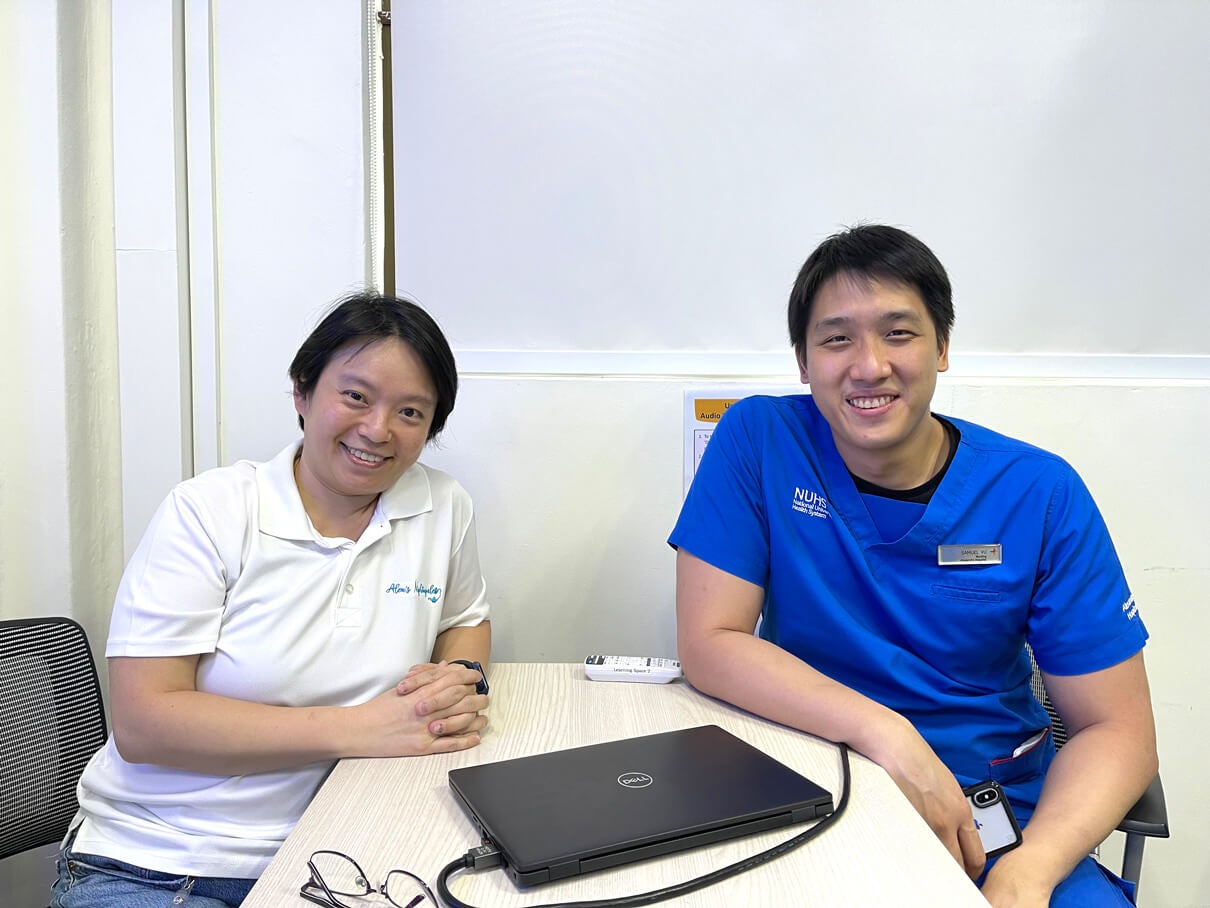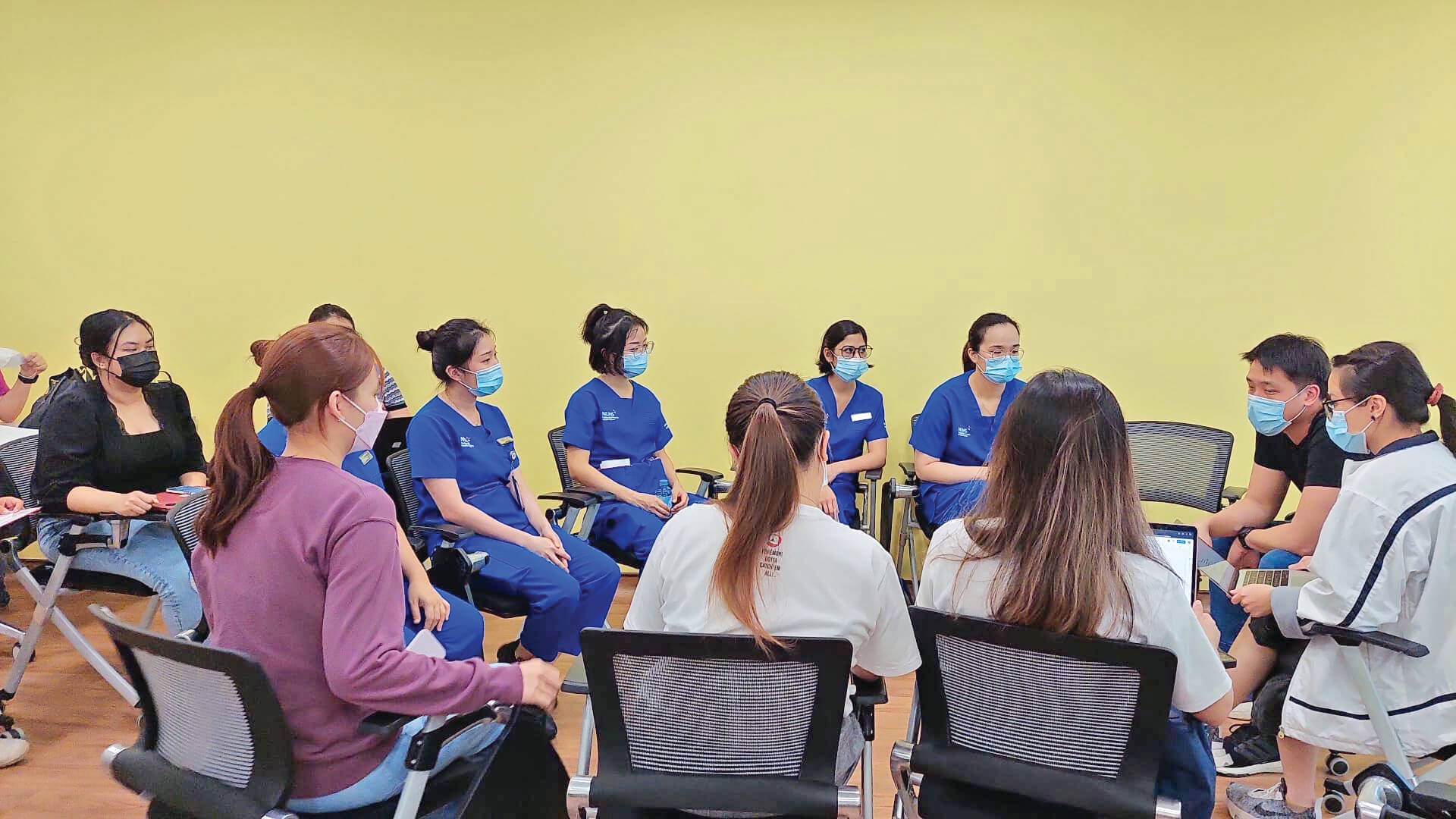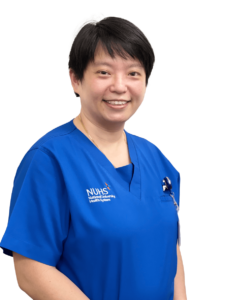They first met in a classroom and became fellow alumni. Now, they are colleagues at Alexandra Hospital (AH), teaming up to implement a new guided framework that can help SG nurses document patient care more effectively.

When Advanced Practice Nurse (APN) Joyce Er initiated implementing the SBAR-D (Situation-Background-Assessment-Recommendation-less Duplication) framework in AH last year, Staff Nurse (SN) Samuel Yu was one of the members in the project team. With the successful rollout of the pilot, NUrSing sat down with Joyce and Samuel to understand what the framework is all about, what inspired it, and its positive impact on productivity all-round.
NUrSing: First things first—how did the two of you get to know each other?
Joyce: I was the project leader for this framework, so I gathered a few nurses from different wards to collaborate with me. Samuel was one of the participants who helped to run the project in the pilot ward—which happens to also be my ward.
Samuel: Sister Joyce taught me in one of my Year 2 modules when I was still a student at the Alice Lee Centre for Nursing Studies (NUS Nursing), National University of Singapore Yong Loo Lin School of Medicine. But maybe I wasn’t a good student—that’s why she didn’t bring it up? Working on this project together, however, is very different from school and I enjoyed the working relationship we share very much.
Joyce: Agreed—Samuel is like my right and left hand in this project. But of course, SBAR-D couldn’t have happened without the strong support of our other team members too.
NUrSing: Interesting. So how did the idea of the SBAR-D framework first come about?
Joyce: As a relatively young hospital with a young Nursing cohort, we are always on the lookout to improve the quality of nursing care and patient outcomes. Particularly, it came to our management’s attention that despite advancement in technology and SG nurses becoming more knowledgeable and skillful, they are actually moving further away from the bedside and having less direct contact with patients.
Therefore, we thought to pilot an evidence-based implementation framework. The idea is to apply the SBAR-D framework in the Next Generation Electronic Medical Record (NGEMR) system’s free text documentation section to help SG nurses write effective nursing documentation. Additionally, we hope the introduction of the SBAR-D framework will return nurses to the bedside, improve their clinical competencies and save their time spent on administrative tasks.
NUrSing: Can you tell us more about SBAR-D—what is it and how does it work?
Joyce: SBAR-D is a framework that builds off the SBAR handoff process1—a validated tool for effective communication in healthcare settings. But our framework comes with a novel implementation—Situation, Background, Assessment, Recommendation, minus Duplication. Essentially it provides SG nurses with a guided framework to help them write in a logical, sequential and meaningful manner.
Samuel: Indeed—as a user of the tool myself, I really appreciate the structure the framework offers. It makes writing notes faster, easier and clearer. On a hectic day or when the patient is not stable, just having an easy-to-follow structure really makes a difference to ensure that we are documenting important things in a clear and concise manner. It is a simple guide to remind nurses to write what they thought, but wouldn’t have done so unprompted.
Joyce: That is right—before our introduction of this framework, nurses simply wrote what they wanted. As a result, there was no consistency. The quality of the information also varied significantly from nurse to nurse. We aim to solve these problems with SBAR-D.
NUrSing: Did the team face any challenge rolling out the SBAR-D framework? How did the team overcome them?
Joyce: During our intervention, we noted that nurses want to do a good job with their documentation. However, due to their lack of confidence, they struggle with what to include in their notes—and often end up overwriting to compensate. For example, they always ask if they see a patient with 10 clinical conditions, should they write all 10 into their notes? So we say “no”. We explain that the background we are looking for is the one relevant to the current situation and the patient’s current condition.
Samuel: Another problem we saw was— that nurses do a lot, but they don’t include their actions in their notes as they are unsure if they should write what they’ve done. So these remain unknown to doctors and other healthcare workers who are working in collaboration to manage the patient’s condition. With SBAR-D, we want to encourage SG nurses to include their recommendations. That is why during our training with them, we would assure them that what they were doing was already the best action plan—and fulfils the “R” under the SBAR-D framework.
NUrSing: Can you also tell us more about the “minus D” component in the framework?
Joyce: Yes. The NGEMR is a very comprehensive system which captures pertinent information such as vital signs, intake, output and more. But we found some nurses repeating these same information in their written notes. That’s why we added the “minus D” in the SBAR-D framework to remind them not to duplicate information already available elsewhere in the NGEMR.
Samuel: Also because different healthcare personnel like doctors, nurses, physiotherapists, etc., see different interfaces on the NGEMR, there is a tendency for nurses to take the extra effort to double or triple write things into different places with the hope of keeping everyone informed and on the same page. However, this practice is unproductive because it is time consuming and takes our time away from caring for patients. We make a conscientious effort to cut that out with the “minus D” component—and get everyone to learn and embrace features offered by the NGEMR instead.
NUrSing: What were some outcomes observed from the pilot evidence-based implementation?
Joyce: There are a few areas where we have seen encouraging results. The compliance rate for writing documentation in a structured, consistent and relevant way increased from 10% to 65% over the two-month period. We also observed approximately 20% savings in time spent on documentation. But perhaps, for me the most gratifying moments are when I am on the ground doing handover with my nurses or standing next to them to discuss their notes and the framework—that “aha” moment, their elation when they got it down correctly, and their genuine interest in using the framework to do their job better.
Samuel: Similarly for me, since adopting the SBAR-D framework for my work, I felt more confident when making assessments and putting in my recommendations. Previously, when I write notes, I wasn’t sure who will read them, or if they will be of use to anyone. But now, when I write them—because they are clearer with the use of the framework—I have on quite a few occasions experienced other healthcare professionals referring to my notes to jumpstart their diagnosis and decisions. It feels good to contribute and be a valued member of the healthcare team.
Joyce: That is how empowering the SBAR-D framework is. Like Samuel, many participating SG nurses are not only embracing the framework and becoming more proficient in using it, but also gaining confidence in their own clinical capabilities. This growth is invaluable.

NUrSing: What is next for SBAR-D?
Joyce: We started with one ward in AH—and as we speak, we have already introduced the framework to two more wards. Our plan is to move on to another two wards later in the month. By the end of the year, we should complete the rollout to the whole hospital.
We are taking a step-wise approach in this implementation because we wanted to make sure that the implementation is done right. Along this journey, we make a point to continue learning and finetuning to ensure that it stays on track. As AH is part of the National University Health System, the hope is also that SBAR-D will eventually spread through the whole cluster.
1Stewart, Kathryn R., and Kelli A. Hand. “SBAR, Communication, and Patient Safety: An Integrated Literature Review.” MedSurg Nursing, vol. 26, no. 5, Sept.-Oct. 2017, pp. 297+. Gale Academic OneFile, link.gale.com/apps/doc/A514512708/AONE?u=googlescholar&sid=bookmark-AONE&xid=1966b574. Accessed 13 Mar. 2023.




